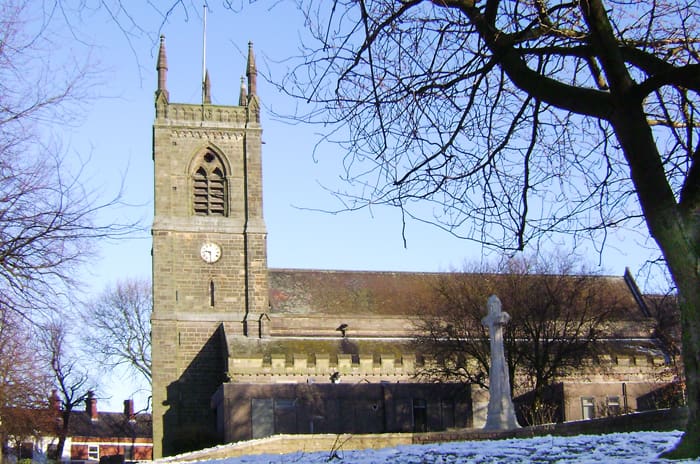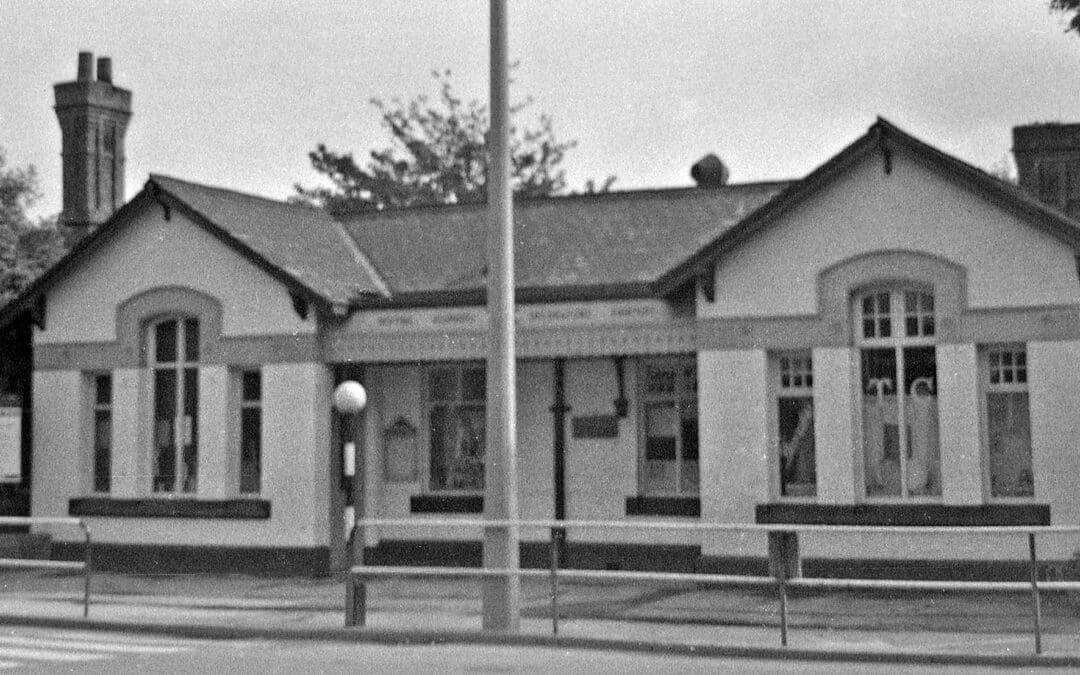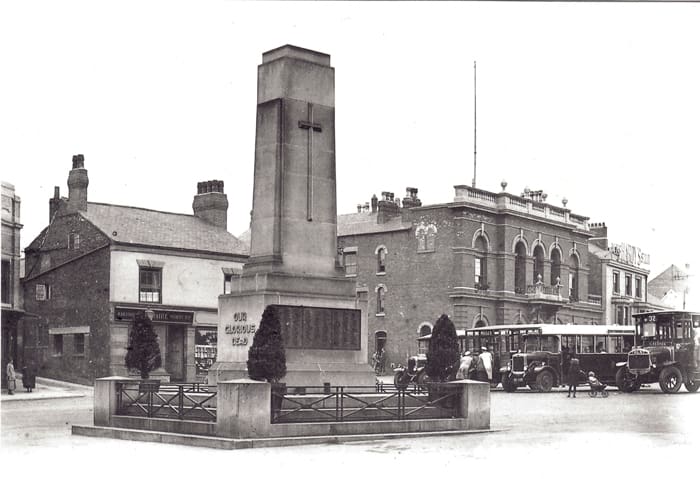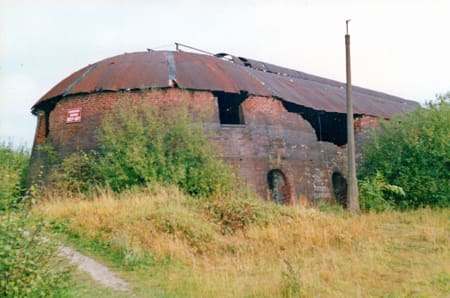Cotmanhay: Christ Church — formerly on Church Street
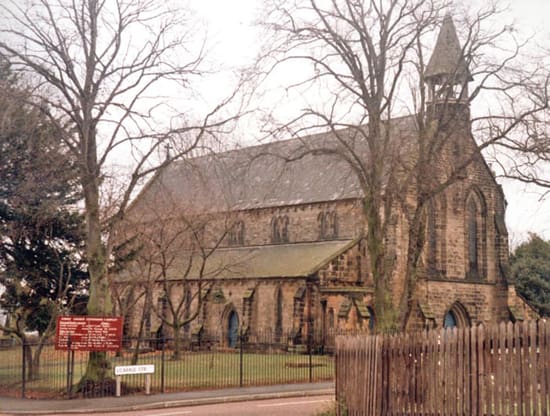
The Parish of Cotmanhay was formed in 1845, partly out of the parish of Ilkeston and embracing Shipley.
The church was erected in 1848, at a cost of £2,600, raised by subscription and from Government grants. The Duke of Rutland also donated £200 and the site.
It was a stone building in the Early English style with lancet windows. Other features of note were a ‘Kempe’ window, a richly painted and gilded tripych and linenfold panels in the sanctuary and a wrought iron choir screen.
Demolished in 1983 after it was discovered that mining subsidence had caused serious structural damage.
Cotmanhay: Methodist Chapel — corner of Bridge Street and Cotmanhay Road
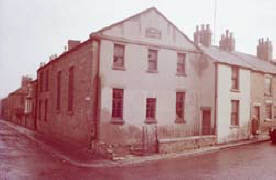
Cotmanhay: Cotmanhay Primitive Methodist — Cotmanhay Road
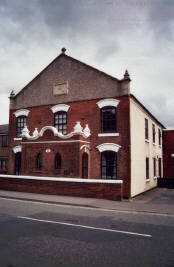
(Stephen Flinders)
Built in 1853 at a cost of £500.
A Sunday School also existed on Wesley Street.
The extant building has been converted to residential use.
Hallam Fields: St Bartholomew
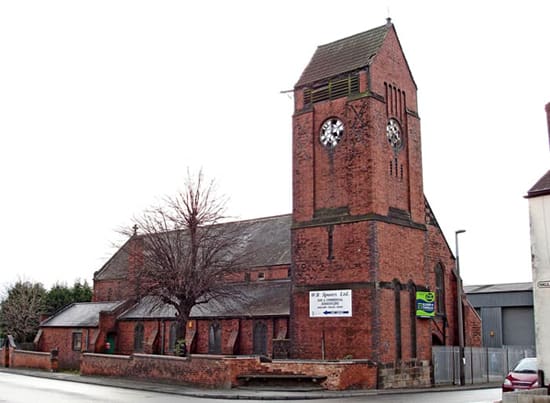
A red brick building built in 1896 to a design by P Currey of Derby in the Early English style, St Bartholomews was built in 1895 in red brick with stone dressings. A saddle-backed roof was added in 1905, along with a clock tower with a chiming mechanism. Four more bells were added in 1911.
It was built to serve the needs of some 1000 people living at Hallam Fields, most of who worked at the Stanton Iron Works. Its predecessor had been a temporary iron church, built in 1880 and later re-erected at Station Road.
The church was consecrated in 1896 by the Bishop Suffragan of Derby and served the community until its closure in 1969.
Ilkeston: All Saints at Larklands — Park Road
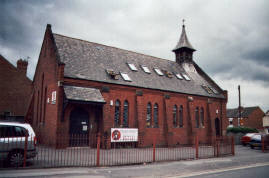
Built just before the outbreak of the First World War, All Saints was built on the site of the former Larklands Mission (see below).
The extant building is now a childrens’ day nursery.
Ilkeston: Baptist Chapel — South Street
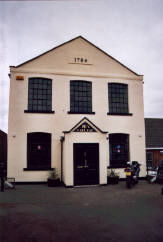
(Stephen Flinders)
Built in 1784/5, it had an internal gallery added shortly afterwards. It was further extended in 1842. The chapel was originally opened for the use of Baptists from Little Hallam, whose original chapel — built in 1767 — is said to have stood somewhere on the present Little Hallam Hill. To the south side of the chapel — on the site of Robey Yard — stood the original Sunday School rooms.
Following the opening of a new and much larger chapel on Queen Street, the main building itself was used as a Sunday School. The building is now ‘The Latch Lifter’ bar and music venue.
The extant Grade 2 listed building stands adjacent to South Street Medical Centre.
Ilkeston: Baptist Chapel — Queen Street
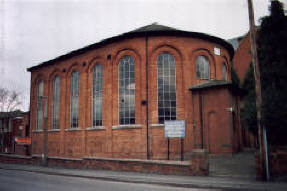
(Stephen Flinders)
Erected in 1858 at a cost of £1,400, on land purchased by auction from the estate of a Mr Lowe. The architect was Mr Booker of Nottingham and the builder, Mr Jedediah Wigley of Ilkeston. The building originally accommodated 400 worshipers until in 1883 when a gallery was added, increasing its capacity to 500. The chapel is a Grade 2 Listed Building.
The Baptists’ former place of worship, to which a burial ground was once attached, was later used as a Sunday School (see above).
Ilkeston: Church of the Nazarene — Corporation Road
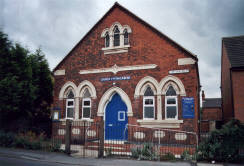
(Stephen Flinders)
The church was opened on South Street in 1940 and later moved to the premises of the former Wesleyan Church on Corporation Road in 1964.
The present building was built in 1893.
Ilkeston: Former Ebenezer Methodist Church — junction of Heanor Road and Charlotte Street
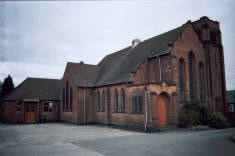
(Stephen Flinders)
Built in 1936 to replace one on Awsworth Road which dated back to 1850, this Church fell out of use in the 2010’s and is now an arts gallery.
(Photograph — Stephen Flinders)
Ilkeston: Holy Trinity Church — Awsworth Road and Cotmanhay Road
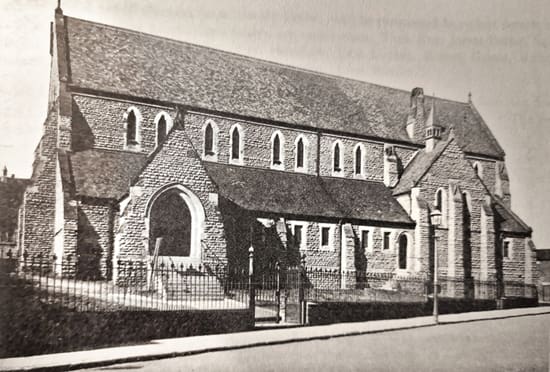
Consecrated in 1884 by Bishop Maclagan (later Archbishop of York). Holy Trinity was built of stone in the Early English style and replaced a mission church built some 30 years previously.
In 1888, the church became the parish church of the newly formed parish of Holy Trinity.
The church consists of a nave with north and south aisles, a spacious chancel and vestries.
Ilkeston: Independent Chapel — Burns Street
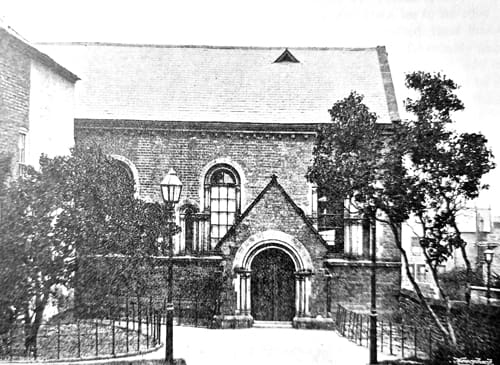
Erected in 1849 at a cost of about £750 and once capable of seating up to 300 worshippers. It is said to have been built on the site of the first Congregational Chapel in Ilkeston, itself erected in 1781.
A burial ground once lay to the chapel’s south side but this was cleared to make way for the Scala cinema which opened in 1913.
The extant building was eventually converted into private apartments in the 1980s.
Ilkeston: Kensington Mission — Nottingham Road
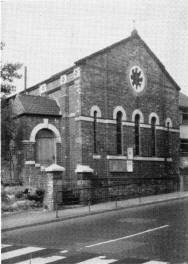
(Erewash Museum)
The Kensington Mission began life as a Sunday School for the education of the area’s poor children. As part of Ilkeston’s Congregational movement, it began in 1864 in a cottage loaned by Benjamin Tatham, a master needlemaker of Needlemakers’ Yard. The school was soon extended to a second cottage and then to a room at the Needlemakers’ Arms. Eventually, a larger space was acquired in the room of a local factory.
By 1866, land had been acquired opposite the junction of Nottingham Road and Park Drive for the construction of purpose built premises. These were erected around the year 1869 at a cost of £300.
Ilkeston: Larklands Mission — Park Road
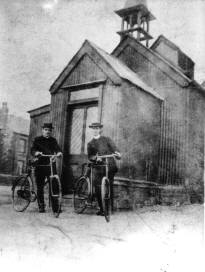
(Erewash Museum)
One of two ‘Tin Tabernacles’ to have stood in Ilkeston.
This photograph shows the mission as it appeared in or around 1912 and features Reverend Mellors (seen on the right).
Ilkeston: Methodist New Connexion — Stamford Street
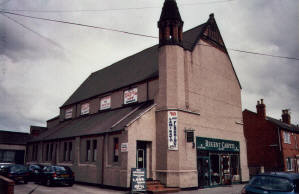
(Stephen Flinders)
The New Connexion was established in the early 1880s and originally occupied the former Wesleyan Chapel on Market Street (now demolished).
The site on Stamford Street was secured and a new church erected in 1889 at a cost of £2,000, inclusive of the land.
The building is of a Gothic design and originally contained the windows from the old Market Street Chapel.
In 1892, an incident took place which resulted in the death of one person and the injury of several others when during a magic lantern entertainment an explosion occurred. The accident also resulted in a certain amount of damage to the church itself.
The extant building is now home to a carpet business.
Morley: St Matthew’s Church
Grade 1
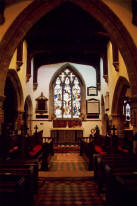
Important church for its architecture, monuments and stained glass. Built in various stages between the 11th and 15th centuries. Monuments include several members of the Sacheverall family, including John Sacheverall killed in 1485 on Bosworth Field. The stained glass, mainly in the north chancel chapel, came originally from Dale Abbey. The late 19th century Grade 2 Listed Bateman mausoleum stands in the church yard.

Ilkeston: Former Nottingham Road Methodist — junction of Nottingham Road and Little Hallam Lane
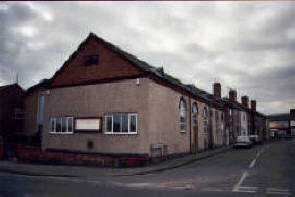
(Stephen Flinders)
Stemming from the need for a place of worship for migrant families from Staffordshire, whose men folk worked at Trowell Forge, the church began in 1875 with the purchase of four cottages on the site of the present church, one of which was used for public worship.
In 1884 the first purpose built church was opened, built in the gardens of the four cottages. In 1897 work began to increase the capacity of the church. This extension work necessitated the demolition of the two cottages which fronted onto Nottingham Road. In 1959 a new church was added to the old school rooms.
Ilkeston: Primitive Methodist Chapel — formerly on Bath Street
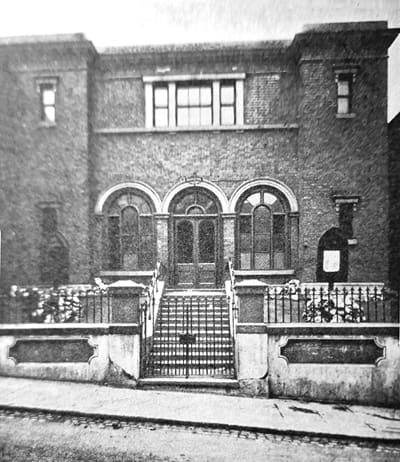
The chapel was built in 1852, at a cost of £1,300. During its time the building was much altered and eventually was capable of seating around 600 worshipers. In 1888, extensive school rooms and a large hall were added on Wilmot Street.
The building was demolished in 1973, along with the Wesleyan Chapel, Bath Street, with whom its members amalgamated to form St Andrew’s, whose church now occupies the same site as the former Primitive Methodist.
Ilkeston: St John The Evangelist — Nottingham Road
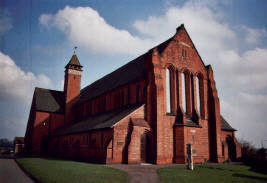
(Stephen Flinders)
St John’s is a brick structure built in the Early English style. Designed by Currey of Derby, and initially built as a chapel of ease to St Mary’s, the foundation stone was laid in 1893 and was dedicated in 1894 by the Bishop of Southwell. Though not fully completed until 1911, it became the parish church of the newly formed parish of St John’s in 1912.
Ilkeston: St Mary’s Church, Market Place
Grade 2
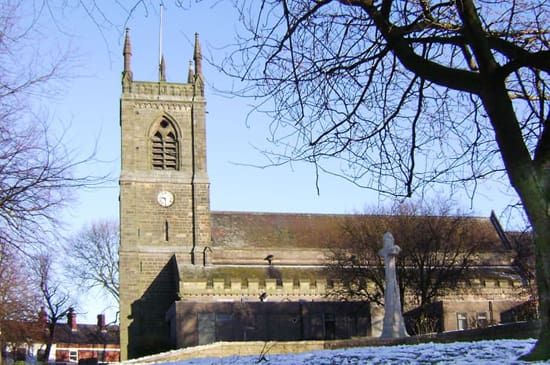
Founded about 1150, the church was extended during the reign of Henry III (1217-21) by Nicholas de Cantelupe, a lord of the manor, whose tomb is in the chancel. The tower, which before 1714, supported a steepled spire was rebuilt in the Grecian style in 1731 and in the Gothic tradition by T L Walker, a pupil of the elder Pugin during a major reconstruction of the fabric in 1854-5. To facilitate an extension to the nave in 1909-10, the tower was taken down and rebuilt further to the west in its present position. See also A Brief History of St Mary’s.
Ilkeston: St Mary’s Mission — formerly at the junction of Station Road and Alvenor Street
(Erewash Museum)
Originally built in 1880 and in use at Hallam Fields for 15 years before the building of St Bartholomew in 1895. St Mary’s Mission was one of two ‘Tin Tabernacles’ to have existed in Ilkeston and was one of the first missions to be set up by the Church Army.
Ilkeston: St Thomas of Hereford — Nottingham Road
(Stephen Flinders)
The Catholic Church of Our Lady of Dale and St Thomas of Hereford is a stone building in the Early English Gothic style and has a slender tower surmounted with a crown. The present building was built around an older church between 1921 and the early 1930s. It is predominantly of Darley Dale stone with a slate roof. The architect was Charles W Hunt. The tower was the final part to be added and the ‘praying hands’ design of the spire is said to have been based on that of St Dunstan-in-the-East in London.
The sanctuary with the high altar is flanked by two side chapels. The Lady Chapel continues the tradition of Dale Abbey. The other chapel is dedicated St Thomas of Hereford, a member of the Cantelupe family.
Ilkeston: Unitarian Chapel — High Street and Anchor Row
(Stephen Flinders)
Designed and built in 1869 by Mr. William Warner.
This replaced an older chapel which stood on the same site.
The extant building is now used as a Masonic Lodge.
Ilkeston: United Reformed Church — Wharncliffe Road
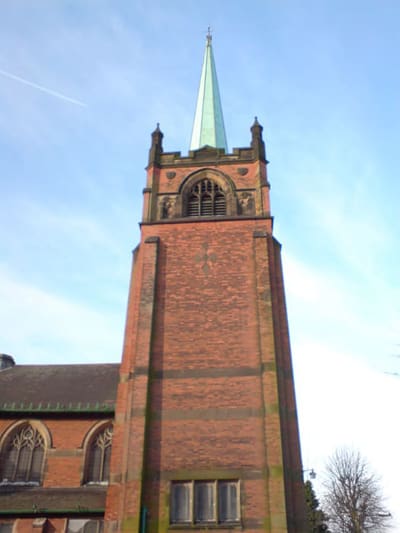
Construction of the church began in April 1904, on land purchased from the Duke of Rutland at a cost of £800.
The church is of red brick and of a Gothic style, the architect being Mr Harry Tatham Sudbury and the builder, Mr Alfred Earnshaw of Burr Lane.
In March 1905 the first gathering on the new premises were held when a grand bazaar was held in aid of the building fund.
The official opening took place on March 22nd with the dedication being carried out by Reverend J. Guiness Rogers of London.
Ilkeston: Market Street Wesleyan New Connexion
This is probably the only illustration of the Market Street Wesleyan New Connexion Chapel which once stood facing the lower part of Gladstone Street. It was built around 1880 in a Gothic Style and had seating for about 200 worshippers.
During its demolition its windows were salvaged and reinstalled in the new chapel built on Stamford Street in 1889.
Ilkeston: Wesleyan Chapel — formerly on Bath Street
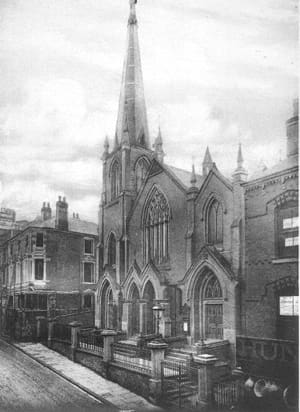
Built in 1873 by Frederick Shaw on the site of the former ‘Fletcher’s Factory’, at a cost (including the purchase of land) of £2,500. Demolished in 1973, the site was occupied by Fine Fare and later Wilko.
Ilkeston: Wesleyan Chapel — formerly at Burgin Yard, later the site of Coronation Street
(David Hudson)
This property became the first Wesleyan chapel in Ilkeston and was used as a Sunday School after a new chapel was built on South Street in 1845 (see below).
Later used as a motor repair garage, the building was eventually demolished during the construction of the Ritz Cinema in 1938.
Ilkeston: Wesleyan Chapel — formerly on South Street
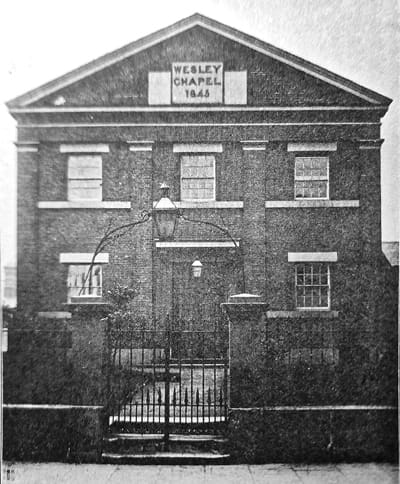
Built in 1845 at a cost of £1,200 and seating 600 worshippers, this building replaced the former chapel situated at Burgin Yard (see above).
Use of the premises for worship ceased in 1957. Despite suggestions to adapt and use the empty building as a car show room or bowling alley, the building was demolished in 1968 and the site used for the erection of the then Ministry of Social Security Offices (now the DWP and Job Centre), a building which stands out like a sore thumb on Ilkeston’s skyline.
Ilkeston: Wesleyan Chapel — formerly on Station Road
The first foundation stones were laid on July 12 1893, one of which by Samuel Eyre a lay preacher at both the chapel and at the Albert Hall Mission at Nottingham.
The opening service took place on November 12 1893, the last taking place in 1989 after which the building became a factory then a warehouse before its demolition in the early 1990s. Houses now occupy the site.
Kirk Hallam: All Saints Church
Grade 1
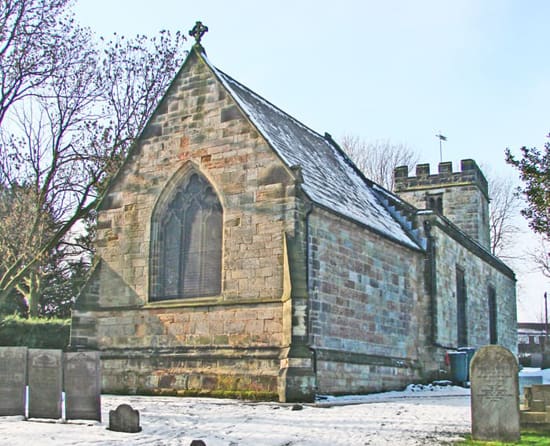
A few Norman details including the font. Perpendicular tower.
Stanley: St Andrew’s Church
Grade 2
Mentioned as the Chapel of Stanley in the taxation roll of 1291. The small round-headed priest’s doorway in the south wall, now blocked up, is a plain example of Norman work, showing clearly that there was a chapel here in the 12th century. A small lancet and some buttresses are from the 13th century building but the church was mainly rebuilt c.1875.
Stanton by Dale: Church of St Michael and All Angels
Grade 2
The chancel windows, north aisle, north and west windows date from around 1300 but the south door has a tympanum with a cross which may be Norman. Handsome south porch.

